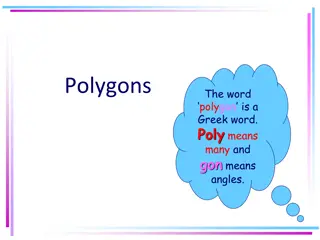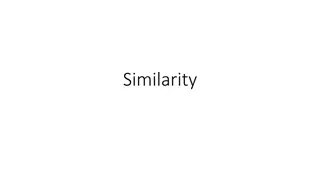Math Review: Distance, Midpoint, Polygons, and Reasoning
Solve distance and midpoint problems, identify polygons, and practice reasoning skills in this comprehensive math review covering topics like coordinate geometry, polygons, and mathematical reasoning techniques.
Download Presentation

Please find below an Image/Link to download the presentation.
The content on the website is provided AS IS for your information and personal use only. It may not be sold, licensed, or shared on other websites without obtaining consent from the author.If you encounter any issues during the download, it is possible that the publisher has removed the file from their server.
You are allowed to download the files provided on this website for personal or commercial use, subject to the condition that they are used lawfully. All files are the property of their respective owners.
The content on the website is provided AS IS for your information and personal use only. It may not be sold, licensed, or shared on other websites without obtaining consent from the author.
E N D
Presentation Transcript
Math 1B Final Review Unit 6 Standards
Day 1: Distance and Midpoint 1. Find the distance between (4, 2) and (-4, -4). 2. What is the perimeter of BDE? 3. Find the distance from (2, 5) to the x-axis.
Day 1: Distance and Midpoint 4. Find the midpoint of the segment connecting (4, 7) to (-2, 3). 5. A ship sails from point (1, 2) to point (5, 5), as shown. At which point had the ship completed exactly HALF of its trip?
Day 1: Distance and Midpoint 6. On a coordinate grid, the movie theater is located at (0, 0) and the mall is located at (4, 3). If the bowling alley is located at the midpoint between the theater and the mall, what is the approximate distance from the bowling alley to the mall? (Note: 1 unit = 1 mile)
Day 2: Polygons (Quads & s) 7. What is the MOST specific name for quadrilateral ABCD? a. rhombus b. trapezoid c. parallelogram d. isosceles trapezoid
Day 2: Polygons (Quads & s) 8. What is the MOST specific name for quadrilateral LMNO? a. parallelogram b. rectangle c. rhombus d. square
Day 2: Polygons (Quads & s) 9. The points (5, 3), (3, -4), (10, 3), and (8, -4) are the vertices of a polygon. What type of polygon is formed by these points? a. Parallelogram b. Pentagon c. Trapezoid d. Triangle 10. Isosceles triangle ABC has vertices A(0, 0), B(8, 0), and C(x, 12). Find a possible value of x.
Day 2: Polygons (Quads & s) 11. One interior angle of a rhombus is 75 . What are the other 3 angles? 12. In parallelogram ABCD, find m<A.
Day 3: Reasoning (Choose from inductive, deductive, and counterexample) 13.John concludes that, since (x 5) is a factor of the polynomial x2 25, if he performed the long division (x2 25) (x 5), the remainder would be a zero. This is an example of ______________ reasoning.
Day 3: Reasoning (Choose from inductive, deductive, and counterexample) 14. Adam studied the problems to the right and concluded that when you divide exponential terms with the same base, you subtract their exponents. What type of reasoning is he using?
Day 3: Reasoning (Choose from inductive, deductive, and counterexample) 15. Ivan takes the square root of numerous nonnegative numbers and concludes that the square root of a nonnegative number will always be a positive number. Josh says Ivan is wrong because 0 is a nonnegative number and 0 = 0, which is not positive. What type of reasoning is Josh using?
Day 3: Reasoning 16. Based on the given statements, which statement must be true? I:If Sarah makes all A s and gets a scholarship, she will attend a four-year college. II:Sarah will attend a junior (two-year) college. III:Sarah made all A s. a. Sarah did not get all A s b. Sarah did not get a scholarship c. Sarah made all A s and got a scholarship d. Sarah attends a four-year college and has a scholarship
Day 3: Reasoning 17. First, write the inverse, converse, and contrapositive of the following statement. If two lines intersect to form a right angle, then they are perpendicular. Then, decide whether each of these four statements are TRUE or FALSE.
Day 4: Mixed Review 18. Parallelogram ABCD has the following coordinates. A: (1, -3) B: (1, 0) C: (4, 2) What are the coordinates of point D? 19. Square ABCD has the following coordinates. A: (2, 2) B: (1, 4) C: (3, 5) Find the coordinates of point D.
Day 4: Mixed Review 20. We can find the length of FG using the Distance Formula: FG = (3 1)2 + (-1 3)2 Which formula also represents the length of FG? a. FG = 4 + 2 b. FG = (4 + 2)2 c. FG2 = 42 + 22 d. FG2 = 42 + 22
Day 4: Mixed Review 21. To find the length of AC, we could use the Pythagorean Theorem and AC2 = 32 + 22. What other formula could we use? a. AC = (0 + 3)2 (1 + 3)2 b. AC = (0 + 1)2 (3 + 3)2 c. AC = (0 3)2 + (1 3)2 d. AC = (0 1)2 + (3 3)2
Day 4: Mixed Review 22. Given: Two angles each measure less than 90 . Conjecture: The angles are complementary. If the given statement and conjecture are false, find a counterexample to show this. 23. Jamal states that the conjecture is true: If a and b are integers, then a b is an integer. Provide a counterexample to prove this conjecture false.
Day 5: What should I study for this final? Triangle Centers! Angle bisectors intersect at INCENTER Altitudes intersect at ORTHOCENTER Perpendicularbisectors intersect at CIRCUMCENTER Medians intersect at CENTROID How to find distance/length and midpoint given 2 points or a graph. ***The SHORTEST distance is the PERPENDICULAR distance*** ***How is the PYTHAGOREAN THEOREM related to the DISTANCE FORMULA?***
Day 5: What should I study for this final? Reasoning/Logic Inductive & Deductive reasoning Conjecture & Counterexample Converse, Inverse, & Contrapositive (truth values) Special Quadrilaterals Parallelogram, Rhombus, Rectangle, Square, Trapezoid, Isosceles Trapezoid, Kite How they LOOK in the coordinate plane Their special properties (especially about their angles!) Sum of interior angles of a quadrilateral
Day 5: What should I study for this final? If x2 = 16, x = ? Random Vocabulary Complementary Supplementary Integer, Nonnegative Perpendicular/right angle Parallel Perimeter Area Vertex, Vertices Important Formulas Slope: m = (y2 y1)/ (x2 x1) Pythagorean Thm: a2 + b2 = c2 Distance: d = (x2 x1) 2 + (y2 y1) 2 Midpoint: M=( x1 + x2 , y1 + y2 ) ( 2 2 )























